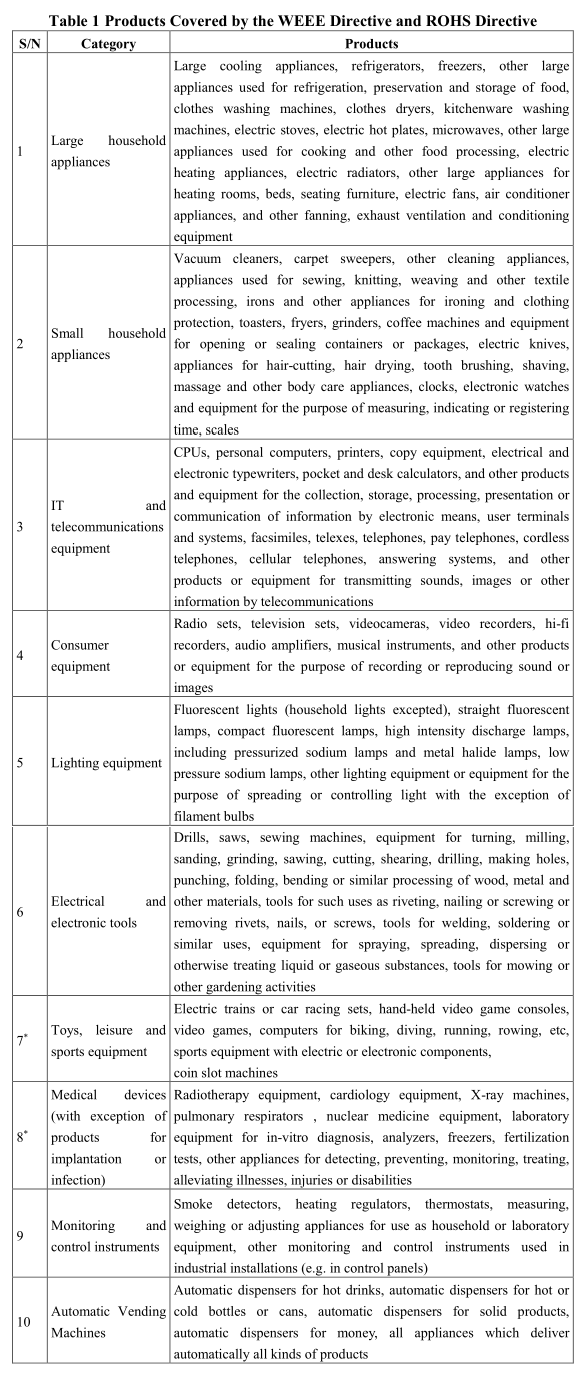Concerns on Technical Barriers Contained in theTwo EU Directives on Electrical and Electronic Equipment (EEE)
Dec 16,2005
Li Zhijun, Management World Magazine
Research Report No.144, 2005
I. Background and Objectives of the "Two Directives"
In order to protect human and animal health and the environment, after ten years of discussion and consultation, Directive 2002/96/EC of the European Union on Waste Electrical and Electronic Equipment (the WEEE Directive) and Directive 2002/95/EC of the European Union on the Restriction of the Use of Certain Hazardous Substances in Electrical and Electronic Equipment (ROHS Directive) (hereafter the "Two Directives") came into force within the European Union on February 13, 2003. The EU required that its member states bring the "Two Directives" into their laws, regulations and administrative provisionsbefore August13, 2004.
According to the WEEE Directive, producers of waste electrical and electronic equipment (WEEE) including importers and distributors are responsible for the recovery and disposal of waste electrical and electronic products put on the EU market starting from August 13, 2005; for products put on the market before August 13, 2005, the financing of the costs of management shall be provided by producers according to their respective market shares. The ROHS Directive provides that starting from July 1, 2006, new electrical and electronic equipment put on the EU market shall not contain six hazardous substances, including lead, mercury and cadmium.
The background of the "Two Directives" can be summarized in three regards:
The first is the need to harmonize the laws of EU member states and eliminate barriers between them. The disparities between environmental laws adopted by member states created trade frictions for electrical and electronic products, and impeded the normal circulation of commodities. Therefore, it was necessary to harmonize the laws of member states to normalize trade between member states in this field and unify EEE requirements on the EU market. As a result, by taking the advantage of an integrated EU market, the EU finally reached consensus and brought forth the "Two Directives" after ten years of discussion, consultation and preparation.
The second is the need to control ecological damage and environmental pollution, ensuring the sustainable development of EU industries, and boosting the EU’s image as a pioneer in environmental protection. All EU member states boast advanced technologies, high-developed economies and high living standards. People in the EU are highly conscious of the environmental protection. And the transnational Green Parties in the EU are gaining political influence and status daily. EU had put forward holdings on cleaner production, ecological industry and recycling economy quite early. However, these objectives cannot be achieved without high awareness on the national level, science and technology, and highly-developed economy and laws and regulations. The "Two Directives" are intended to accommodate this need and trend.
The third is the need to promote competitive edge of EU products on international markets and protect the internal EU market. The implementation of the "Two Directives" is favorable for promoting the competitiveness of EU manufacturers and products internationally. It is obviously aimed to exert the advantages of European Union, promote market competitiveness and protect and scramble for more economic benefits. Meanwhile, the EU is setting up technical standards and codes that are difficult for developing countries to meet, and thus protecting its own products and markets using the pretext of human health and environmental protection. Although most of the daily-use industrial products produced in developing countries under US brands are sold in US, a considerable portion is still sold to other countries, especially European countries. The EU intends to counterbalance the US with high technical barriers.
The objectives of the "Two Directives" are to promote the performance of relevant operators in achieving environmental protection, and prevent or minimize WEEE environmental pollution by harmonizing laws and administrative measures adopted by the member states regarding the disposal of WEEE. To be more concrete, the WEEE Directive takes as a first priority the prevention of the production of WEEE, and then the promotion of reuse, recycling and other forms of waste recovery so as to reduce waste volume. It also seeks to improve the environmental performance of all operators in the life cycle of electrical and electronic equipment, e.g. producers, distributors and consumers and in particular those operators directly involved in the treatment of WEEE. The purpose of the ROHS Directive is to harmonize the laws of the member states on restrictions on the use of hazardous substances in electrical and electronic equipment and to contribute to the protection of human health and the environmentally sound recovery and disposal of WEEE.
II. The Main Content of the "Two Directives"
1.The main content of the WEEE directive
(1) Products covered by the WEEE directive
Products covered by the Directive are designed for use with a voltage rating not exceeding 1,000 Volt for alternating current and 1,500 Volt for direct current, and cover the following 10 categories:
a. Large household appliances such as refrigerators, washing machines and microwaves;
b. Small household appliances such as vacuum cleaners, irons, and clocks and watches;
c. IT and telecommunication equipment such as computers, copying equipment and printers;
d. Consumer equipment such as televisions;
e. Lighting equipment such as fluorescent lamps;
f. Electrical and electronic tools such as saws and sewing machines;
g. Toys, and leisure and sports equipment;
h. Medical devices;
i. Monitoring and control instruments;
j. Automatic vending machines

Note: * Indicates an item which is not currently covered by the ROHS Directives.
…
If you need the full text, please leave a message on the website.














